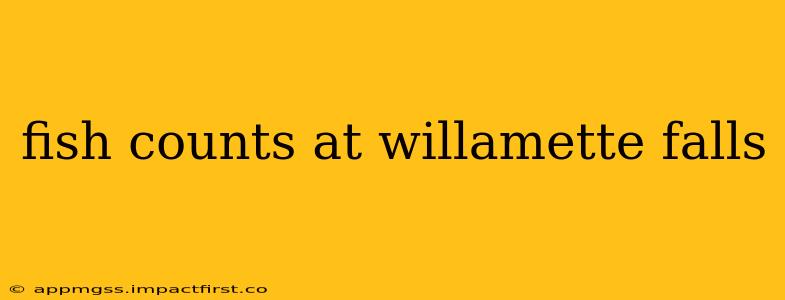Willamette Falls, a historically significant location in Oregon, has seen dramatic changes in its fish populations over the years. Understanding the current fish counts and the factors influencing them is crucial for conservation efforts and the overall health of the Willamette River ecosystem. This article delves into the complexities of fish counts at Willamette Falls, exploring the methods used, the challenges faced, and the implications for the future.
What methods are used to count fish at Willamette Falls?
Fish counts at Willamette Falls utilize a variety of sophisticated techniques, aiming for accuracy and comprehensive data collection. These methods are constantly being refined to improve efficiency and address the unique challenges of counting fish in a dynamic river environment. Common methods include:
- Acoustic telemetry: This technology uses sonar to detect tagged fish, allowing researchers to track their movements and monitor their presence within specific areas of the falls.
- Visual counts: Trained observers stationed at strategic locations visually count fish passing through designated areas. While labor-intensive, this method provides valuable data on species composition and abundance.
- Video monitoring: Cameras strategically placed along the Willamette River record fish passage, enabling later review and analysis. This method allows for review and verification of counts, minimizing errors.
- Trap counts: In some cases, traps are used to capture and count fish, providing more detailed information on individual fish characteristics. This method, while effective, must be carefully managed to minimize stress on the fish populations.
What species of fish are counted at Willamette Falls?
The Willamette Falls are a critical habitat for numerous fish species, and comprehensive counts are undertaken to monitor their populations. Key species of interest include:
- Salmon: Various species of salmon, including Chinook, Coho, and Steelhead, migrate through Willamette Falls. These runs are of significant ecological and cultural importance.
- Lamprey: These ancient, eel-like fish are also important indicators of ecosystem health. Their presence and abundance reflect overall water quality and habitat conditions.
- Sturgeon: White Sturgeon, a large, long-lived fish, is another species of concern. Their populations have faced significant challenges due to habitat degradation and other factors.
- Other native fish: Many other native fish species utilize the Willamette River and pass Willamette Falls during their life cycles. Monitoring these species contributes to a complete picture of ecosystem health.
How accurate are the fish counts at Willamette Falls?
The accuracy of fish counts at Willamette Falls is a complex issue. While the methodologies employed are scientifically rigorous, several factors can influence their accuracy:
- Water clarity: Turbid water can make visual counts challenging, potentially underestimating fish numbers.
- Fish behavior: The behavior of fish, influenced by water flow, temperature, and other environmental factors, can also impact the accuracy of counts.
- Technological limitations: Even advanced technologies like acoustic telemetry have limitations, such as the potential for missed detections or interference from other sources.
- Data analysis: The accuracy of the final counts also depends on the rigor and quality of data analysis techniques used.
What are the challenges in counting fish at Willamette Falls?
Counting fish at Willamette Falls presents unique logistical and environmental challenges:
- High water flow: The strong currents and varying water levels in the Willamette River make accurate counting difficult.
- Difficult terrain: Access to the river and the falls can be challenging, impacting the feasibility of certain counting methods.
- Funding limitations: Sufficient funding for ongoing monitoring and research is crucial for long-term data collection and effective conservation efforts.
What are the implications of fish counts for Willamette Falls?
The fish counts at Willamette Falls provide vital data for conservation management and planning. This information allows researchers and managers to:
- Assess the effectiveness of restoration projects: Data helps evaluate the success of habitat restoration efforts designed to support fish populations.
- Inform policy decisions: The data informs policy decisions related to water management, habitat protection, and fisheries regulations.
- Monitor the impact of human activities: Fish counts help assess the effects of human activities, such as dam operations and water pollution, on fish populations.
- Track long-term population trends: Long-term monitoring provides insights into population trends, enabling proactive conservation strategies.
How can I access the fish count data for Willamette Falls?
The specifics of accessing Willamette Falls fish count data will depend on the agency or organization collecting the data. It's recommended to contact Oregon Department of Fish and Wildlife (ODFW) or other relevant agencies directly for information on data availability and access. They are the primary sources of this information and can guide you on specific data sets and formats.
This information provides a comprehensive overview of fish counts at Willamette Falls. The ongoing efforts to refine counting methodologies and improve data analysis underscore the commitment to understanding and protecting the unique ecosystem of this historically important location. Understanding the nuances of fish counts and the challenges faced is vital to the success of long-term conservation strategies for the Willamette River.
